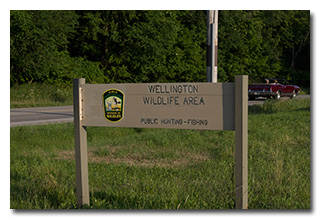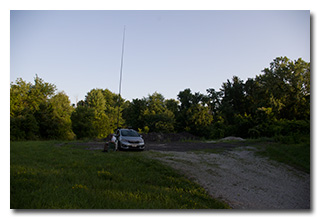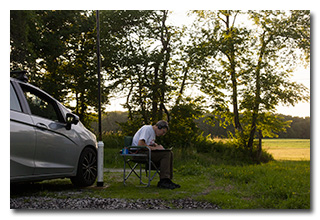
by William Eric McFadden
From the Wellington Wildlife Area website:
-
Two ponds on the area contain largemouth bass, bluegills, and bullheads. Cottontail rabbit, ring-necked pheasant, and fox squirrel are the principal game species. Groundhog, white-tailed deer, and all furbearers common to the region are found here. A great variety of both nesting and migrant birds use the area. Of particular interest to birding enthusiasts is the spring migration of songbirds.
Pictures
- The Wellington Wildlife Area sign; photo my Miles McFadden
- Eric's station; photo my Miles McFadden
- Eric operating; photo my Miles McFadden
Description
 On Saturday, July 8, 2023, two members of the Southeast Ohio Radio Adventure Team
performed a successful activation of Wellington Wildlife Area (K-9515) in Ohio as part of the Parks on the Air
(POTA; link) program.
On Saturday, July 8, 2023, two members of the Southeast Ohio Radio Adventure Team
performed a successful activation of Wellington Wildlife Area (K-9515) in Ohio as part of the Parks on the Air
(POTA; link) program.
Following a successful activation of Findley State Park (link), Eric McFadden, WD8RIF, and Miles McFadden, KD8KNC, drove 1.1 miles to the Wellington Wildlife Area parking area on Griggs road for a Late Shift activation.
Arriving at the Griggs Road parking area about 2340 UTC, Eric and Miles deployed the 228½' end-fed wire vertical on a 31' Jackite fiberglass mast in a drive-on base. Placing his Elecraft KX3 on the swing-up table of his folding camp-chair beneath the mast, Eric was on the air at 0000 UTC.
Eric was pleased to find he had good cell-signal at this location and would be able to spot himself on the POTA Spots website and to use POTA Spots to identify possible Park-to-Park (P2P) QSOs.
Eric began his operation on 40m by finding himself a frequency to run and calling "CQ POTA", self-spotting himself on POTA Spots. His first QSO came at 0002 UTC with N1XV in New Jersey. Despite an S5 to S7 noise-floor, QSOs came quickly, with Eric's twenty-second QSO coming at 0023 UTC with KN4UZK in Virginia. This run included QSOs with operators located in New Jersey, North Carolina (2), Illinois (3), Virginia (5), Tennessee (3), Michigan, Delaware, Pennsylvania, New York, South Carolina, Ontario (2), and Indiana (2).
In all, Eric made twenty-two QSOs in twenty-three minutes. All of Eric's QSOs were CW and were made at five watts output.
Miles did not operate but helped with station set-up and tear-down and he did all the activation photography.
(return)

